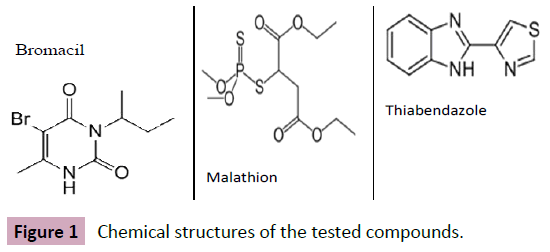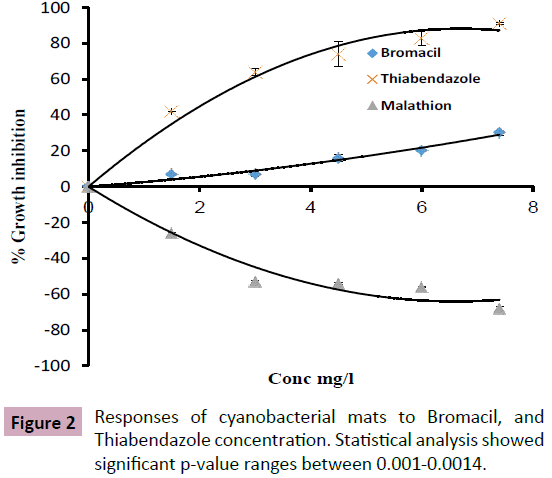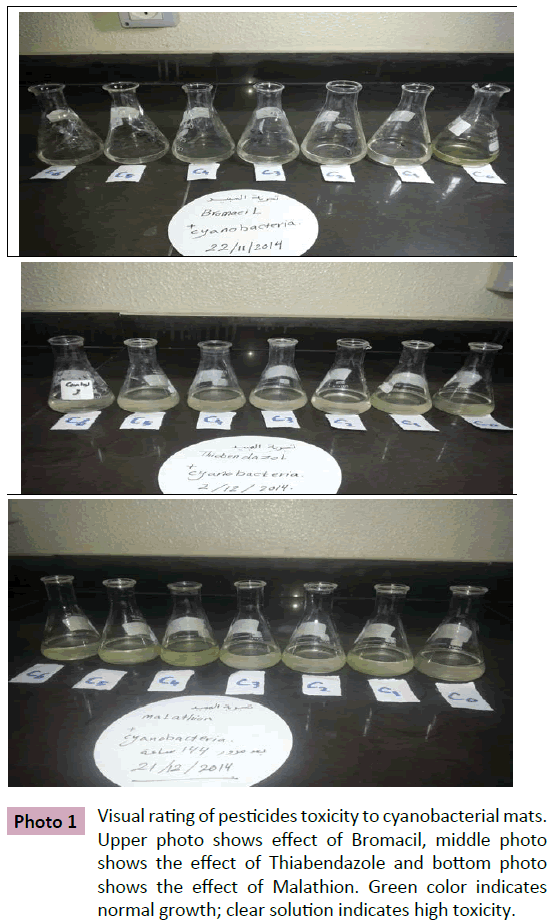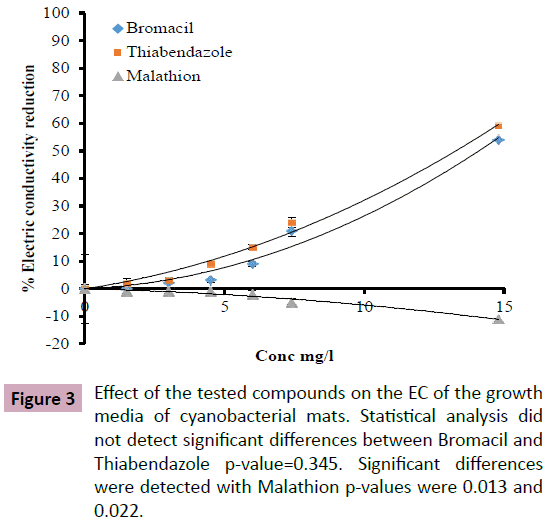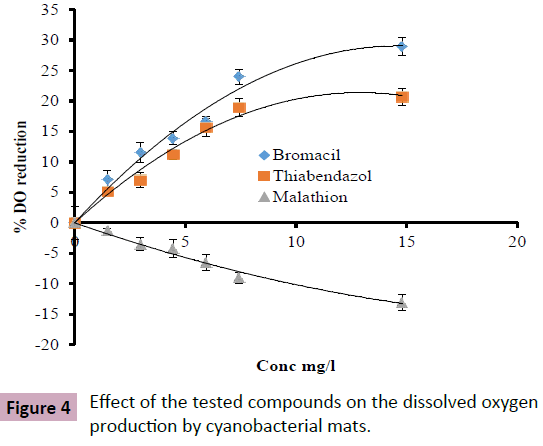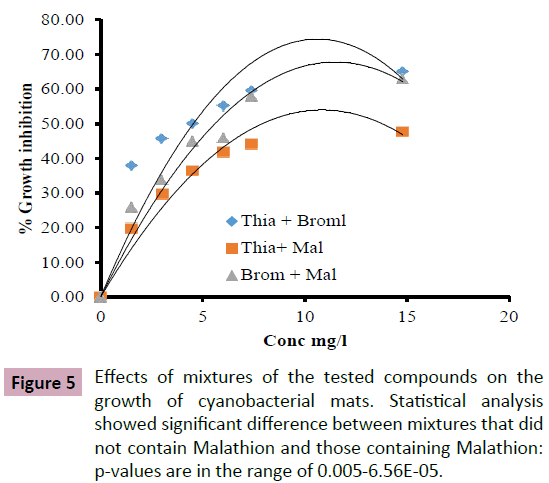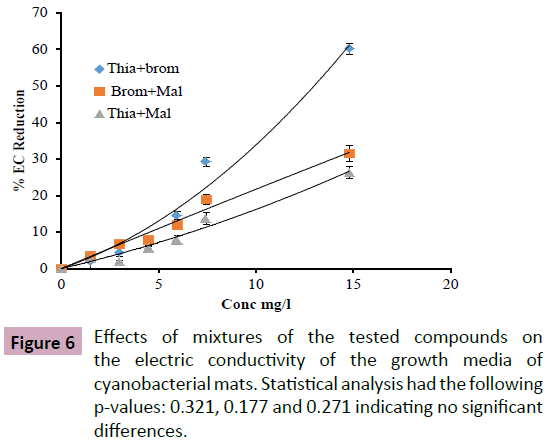Keywords
Cyanobacteria; Pesticides; Growth inhibition; Ammonium; Electric conductivity
Introduction
Cyanobacteria are important organisms in the ecosystems. They produce oxygen [1], organic nitrogen [2], and remove pollutants [3-5]. However, they are non-target organisms, unicellular and typically found in mats. Pesticides may severely damage the population growth and structure of cyanobacterial mats that resulted in disturbance of photosynthetic activity and protein production in the ecosystems.
Cyanobacterial mats may be exposed directly to pesticides or indirectly throughout their metabolites. So far, it has been shown that pesticides reach cyanobacterial mats through waste water [6,7].
Application of pesticides resulted in food contaminations [8], hazards human life [9-12], and other organisms [13] that are not being targeted. Mixtures of pesticides may produce or reduce the effect than the single compound. This phenomenon can be referred as additive synergistic or antagonistic effects [14]. The harmful effects of pollutants on aquatic organisms [15-17] have been studied.
Several articles tested the responses of cyanobacterial mats to pesticide concentration in single form [7,18,19] or mixed form [20,21] Bromacil, Malathion, and Thiabendazole are herbicide, insecticide, and fungicide respectively. They are widely used in Gaza Strip, Palestine, for indoor and outdoor pest management and their applications created many environmental problems. Several authors revealed their toxicity to fish (El-Nahhal et al., 2015, Hams 2015), but the information about their effects on aquatic organisms, especially cyanobacteria is limited. We designed this work to test the responses of cyanobacteria to Bromacil, Malathion and Thiabendazole in single and mixed forms. The current study used biological and chemical methods to determine the effects of Bromacil, Thiabendazole, and Malathion.
Materials and Methods
Bromacil, purity 99.7%, purity 99.2%, purchased from Novartis and Malathion was supplied by the Ministry of Agriculture in Gaza, Palestine. Physical and chemical properties are shown in Table 1. Chemical structures are shown in Figure 1. Bromacil, Thiabendazole and Malathion were dissolved separately (29.76 mg) in 1000 ml distilled water and used as stock solution. The following concentration ranges (0-5.8 mg L-1) were prepared and tested.
| Name |
Solubility in water mg L-1 |
Kow logP |
Henry constant |
pKa |
| Bromacil |
807-1283 |
1.88 |
- |
9.27 |
| Thiabendazole |
30-160 |
2.39 |
2.78* 10^-8 |
4.79 |
| Malathion |
145 |
2.75 |
- |
- |
Table 1: Physicochemical properties of the tested compounds (these data are collected from Tomlin 2000).
Figure 1: Chemical structures of the tested compounds.
Collection and laboratory culturing of cyanobacteria
All cyanobacterial mat samples were collected and prepared for the experimental work as described by El-Nahhal et al. [7] The collected cyanobacteria were exposed to direct sunlight for several weeks before testing to insure adaptation to the lab condition and to evaluate the growth phases. Population growth of the cyanobacteria was measured by monitoring the optical density of growth solution using a spectrophotometer at a wave length of 680 nm. Growth phases of cyanobacterial mats were monitored in the lab 60 watt tungsten lamps using a 12-light: 12- dark cycle [7] during incubation periods ranged from 0-192 hrs. Average of total dissolved salts was 3337 ± 238 and pH value was 8.53 ± 0.38.
Preparation of cyanobacterial mats stock suspension
Stock suspension of cyanobacterial mats was prepared as previously described [22-24].
Responses of cyanobacterial mats to the tested compounds
Responses of cyanobacterial mats to different concentrations of Bromacil, Malathion and Thiabendazole on cyanobacterial mats were estimated as population growth. In these tests, the effects of five concentrations in the range of 0-29.76 mg L-1 were tested. In this procedure, 1 ml of stock suspension of cyanobacterial mats were added to the above-mentioned concentrations to reach a volume of 25 ml using Erlenmeyer flasks under gentle shaking to insure normal distribution of cells. Percentage of growth was determined by recording the optical density, and then percentage growth inhibition was determined according to El-Nahhal et al. [24].
Effects of Tested Compounds on the Metabolic Activity of Cyanobacteria
Effects on electric conductivity, pH, dissolved oxygen
Effects of the tested compounds on the Electrical Conductivity (EC) of the growth media were measured using a digital electronic device (model, manufacturer, UK). Using El-Nahhal et al. [24] with a slight modification, %EC reduction was determined and regressed over concentrations to determine the concentration required to cause 50% inhibition.
Dissolved Oxygen (DO) values were also determined using a DO meter. Using El-Nahhal et al. [24], DO% reduction was determined and regressed versus concentration to obtain the required concentration that led to 50% reduction of DO production. Similarly, pH values were determined using a digital pH-meter. El-Nahhal et al. [24] was used to determine % reduction.
Fresh biomass of cyanobacterial mat was collected by centrifuging 10 ml bacterial suspension at 10,000 g for 25 min. The supernatant was removed and tubes were air dried. The weight of the tube plus cyanobacterial mat was determined. Knowing the weight of the tube before and after the experiment, the determination of bacterial weight using El-Nahhal et al. [24] enabled calculation of biomass reduction.
Effects of binary mixtures
Solutions of Bromacil, Thiabendazole and Malathion were prepared and mixed together to form binary mixtures having ratios 1:1 (v/v). The above-mentioned concentration range was prepared and tested.
Effects on ammonium production
Based on Nessler method and El-Nahhal et al. [25] modification, concentrations of ammonium hydroxide in the growth media of cyanobacterial mats were determined by adding appropriate amount of Nessler Reagent (K2HgI4) to 50 ml of growth media and allowing the reagent to react with the ammonia present in the sample (under strongly alkaline conditions) to produce a yellowcolored species. A series of standard solutions of ammonium hydroxide in the range of 1-5 ppm were prepared and allowed to react with Nessler reagent (K2HgI4) in alkali media to form yellow color measured at 420 nm. The intensity of the color indicates the concentrations of ammonium hydroxide in the growth media. The linear regression equation between the optical density at 420 nm and the standard concentrations was used to determine the concentrations of all unknown samples of ammonium hydroxide.
Effects of Chemical Mixtures (ECM)
Effects of chemical mixtures were calculated by Hermens et al. [26] equation with slight modification. Accordingly, based on the ECM value, the mixture toxicity can be subdivided into 4 groups: Antagonistic effect (ECM<0), no addition effect (ECM=0), partial addition effect (0< ECM<1) and concentration addition effect (ECM ≥ 1).
Statistical analysis
Each experiment consists of five replicates. Averages and standard deviations of the growth was determined and used to determine % growth inhibition. T-test was used to detect differences among treatments.
Results
Growth phases of cyanobacterial mats under lab condition
Growth phases of cyanobacterial mats under lab conditions showed four phases, which are as follows: Lag phase, log phase, stationary phase and decay phase.
Single Test
Effects on population growth
Effects of Bromacil, Thiabendazole and Malathion on cyanobacterial mats growth are shown in Figure 2. It is clear that Bromacil and Thiabendazole have a strong positive association between the tested concentrations and growth inhibition of cyanobacterial mats, whereas Malathion has a negative association coefficient.
Figure 2: Responses of cyanobacterial mats to Bromacil, and Thiabendazole concentration. Statistical analysis showed significant p-value ranges between 0.001-0.0014.
The effects of these compounds can be visualized in Photo 1. The normal growth of bacteria can be seen in the green color in the control samples (C0) and reduction in the color occurred gradually to become clear solutions at C5 and C6, the highest tested concentrations.
Photo 1: Visual rating of pesticides toxicity to cyanobacterial mats. Upper photo shows effect of Bromacil, middle photo shows the effect of Thiabendazole and bottom photo shows the effect of Malathion. Green color indicates normal growth; clear solution indicates high toxicity.
Effects on Metabolic Activities of Cyanobacterial Mats
Effects on the Electric Conductivity (EC) of the growth media
Effects of the tested compounds on the EC of growth media are presented in Figure 3. It can be seen that EC% reduction is greater as the concentrations of Bromacil and Thiabendazole increased. Bromacil has stronger effects than Thiabendazole, which showed low inhibition. Malathion did not show growth inhibition.
Figure 3: Effect of the tested compounds on the EC of the growth media of cyanobacterial mats. Statistical analysis did not detect significant differences between Bromacil and Thiabendazole p-value=0.345. Significant differences were detected with Malathion p-values were 0.013 and 0.022.
Effects on the pH value of the growth media
Influence of the tested compounds on the pH values of cyanobacterial mats growth media are shown in Table 1. Bromacil and Thiabendazole reduced the pH value of the growth media below that of the control sample. Treatments containing Malathion increased the pH values higher than the control sample.
Effects on Dissolve Oxygen (DO)
This experiment is based on measuring the increase of dissolved oxygen in the growth media of cyanobacterial mats. Results are presented in Figure 4. Treatments containing Bromacil or Thiabendazole reduced the dissolved oxygen content by 25 and 15% respectively as compared with the control sample, whereas treatments containing Malathion did not reduce the dissolved oxygen.
Figure 4: Effect of the tested compounds on the dissolved oxygen production by cyanobacterial mats.
Binary Test
Effect of binary mixture
Effect of binary mixtures on population growth, EC and pH of growth media are shown in Figures 5 and 6.
Figure 5: Effects of mixtures of the tested compounds on the growth of cyanobacterial mats. Statistical analysis showed significant difference between mixtures that did not contain Malathion and those containing Malathion: p-values are in the range of 0.005-6.56E-05.
Figure 6: Effects of mixtures of the tested compounds on the electric conductivity of the growth media of cyanobacterial mats. Statistical analysis had the following p-values: 0.321, 0.177 and 0.271 indicating no significant differences.
Binary mixtures reduced percentage growth inhibition of cyanobacterial mats (Figure 5), increased EC% reduction (Figure 6) and elevated pH value (Table 1) of growth media above the control sample in mixtures containing Malathion.
Effects on ammonium hydroxide production in the growth media
Influence of the tested compounds on ammonium concentrations are shown in Table 2. Ammonium concentrations in the growth media were reduced due to Bromacil and Thiabendazole treatment lower than the control treatment. Malathion treatment enhanced ammonium concentrations above that of the control sample indicating growth of cyanobacterial mats.
| pH |
| Individual effect |
Mixture effect |
| Conc. mg L-1 |
Bromacil |
Thiabendazole |
Malathion |
Conc. u/l |
Thiabendaole+Bromacil |
Thiabendazole+
Malathion |
Bromacil+Malathion |
| 0.0 |
8.39 ± 0.16 |
8.28 ± 0.39 |
8.30 ± 0.24 |
0.0 |
8.69 ± 0.04 |
8.64 ± 0.01 |
8.73 ± 0.04 |
| 1.5 |
8.23 ± 0.62 |
7.95 ± 0.24 |
8.57 ± 0.08 |
1.5 |
8.78 ± 0.01 |
8.65 ± 0.01 |
8.69 ± 0.02 |
| 3.0 |
8.17 ± 0.11 |
7.84 ± 0.22 |
8.66 ± 0.11 |
3.0 |
8.76 ± 0.05 |
8.67 ± 0.01 |
8.68 ± 0.02 |
| 4.5 |
7.74 ± 0.60 |
7.76 ± 0.01 |
8.55 ± 0.02 |
4.5 |
8.76 ± 0.03 |
8.61 ± 0.02 |
8.72 ± 0.04 |
| 6.0 |
7.58 ± 0.04 |
7.55 ± 0.13 |
8.65 ± 0.15 |
6.0 |
8.79 ± 0.05 |
8.66 ± 0.04 |
8.69 ± 0.01 |
| 7.4 |
7.57 ± 0.06 |
7.45 ± 0.29 |
8.76 ± 0.13 |
7.4 |
8.79 ± 0.02 |
8.63 ± 0.03 |
8.68 ± 0.02 |
| 14.8 |
7.21 ± 0.44 |
7.25 ± 0.13 |
8.75 ± 0.11 |
14.8 |
8.72 ± 0.05 |
8.62 ± 0.01 |
8.74 ± 0.02 |
Table 2: Individual and mixture effect of Bromacil, Thiabendazole and Malathion as pH changes.
The effective concentration of each compound (EC50) required to reduce 50% of cyanobacterial mat growth is presented in Table 2. It is observed that Thiabendazole had the lowest EC50 value (1.79 mg L-1) indicating higher toxicity than Bromacil (EC50 value of 12.36). Moreover, mixtures not containing Malathion (Thiabendazole+Bromacil) had a lower EC50 value (5.06 mg L-1) as compared to those containing Malathion (Bromacil+Malathion) that had a higher EC50 value (13.14 mg L-1). Furthermore, R2 values associated with the analysis were in the range of 0.8123-0.9767 indicating a strong positive association. So far, Bromacil and/or Thiabendazole did generate 100% growth inhibition at 96 h. This may be due to ionization potential of the compound (Table 1).
In mixture tests, the concentrations of particular pesticides were half their values in the corresponding individual tests, but mixing Bromacil and Thiabendazole produced growth inhibition similar to two fold concentrations of the individual test. This indicates that mixing Bromacil and Thiabendazole produced additive effects [26].
Discussion
The tested compounds Bromacil, Thiabendazole and Malathion are pesticides widely used to control weed, fungi and insects. They belong to different chemical groups and have different modes of action [27]. Their chemical structures and physicochemical properties Table 1 showed considerable solubility in water with possible ionization due to pKa values. They also have different hydrophobicity due to variation in Kow Log P. These properties enable the compounds to have different fates in the ecosystem. Whenever, they are present as mixtures some chemical or physico-chemical modifications may occur and enable two molecules to behave as a single large one [28].
Growth phases of cyanobacterial mat under lab condition
Growth of cyanobacterial mats under lab conditions showed four growth phases during 150 hour (h) (data not shown). These results agree with the previous studies [7,22]. So far, adaptation phase (lag phase) lasting in 24 h followed exponential growth (log phase) lasting up to 72 h, then a stationary phase up to 100 h followed by a sharp decay up to 150 h. This indicates that the life cycle is too short and the bacteria can start new growth phases. The diversity of cyanobacterial mats in the collected samples may undergo community changes due to different laboratory conditions.
Effects on population growth
Responses of cyanobacterial mats to Bromacil and Thiabendazole concentrations (Figure 2) clearly show a strong positive association between the tested concentrations and growth inhibition of cyanobacterial mats, whereas effect of Malathion has a negative association coefficient. These data suggest that Bromacil and Thiabendazole have a direct effect on cyanobacterial mats, whereas Malathion has no effect.
Moreover, Percent Growth Inhibition (GI%) of cyanobacterial mats increased linearly as concentration of Bromacil and Thiabendazole increased in the growth media up to 7.4 mg L-1. The explanation is that cyanobacterial mats have a diversity of sensitive and tolerant species. The sensitive one cannot survive at concentrations equal or below 7.4 mg L-1, whereas the tolerant species can survive at high concentrations. This explanation agrees with recent results [24], which reported on similar observations with different organisms. In contrast, increased concentrations of Malathion showed negative values of GI%. These data indicate that Malathion did not inhibit cyanobacterial mat growth. The explanation of these results is that cyanobacterial mats degrade Malathion molecules to non-toxic fragments and use them as a source of energy. These results agree [4,5], which reported the derivative ability of cyanobacterial mats for Acetochlor and Diuron. Further support to our results is in Singh et al. [29] report that stated higher levels of Malathion degradation in soil due to a mixed culture of three bacterial strains. In contrast, Ibrahim et al. [30] investigated the growth of three strains of filamentous cyanobacteria under different concentrations of Malathion and found a sharp decrease in the growth of filamentous cyanobacterial by increasing the concentration of Malathion. These variations are due to community structure of cyanobacterial mats and/or the temperature, intensity of light and/or relative humidity in laboratory. Statistical analysis showed significant variations (p-values 0.001-0.0014).
A green color in the control samples (C0) (Photo 1) and reduction in the color occurred gradually to become clear solutions at C5 and C6, the highest tested concentrations.
Effects on the Electric Conductivity (EC) of the growth media
The data in Figure 3 clearly show that EC% reduction is greater as the concentrations of Bromacil and Thiabendazole increased in the growth media. EC% reduction was more pronounced in the case of Bromacil and reached about 25%, whereas the same concentration of Thiabendazole did not exceed 10%. For Malathion, a negative value was obtained indicating no inhibition. However, for all cases a strong positive association between the tested concentrations and EC% reduction was observed. R2 values were above 0.96.
Long-term effects (data not shown) of tested compounds on the EC of growth media of cyanobacterial after 96 h did not show significant differences between this and previous results (Figure 3). EC% reduction was more pronounced in the case of Thiabendazole than Bromacil and reached about 63%. In case of Malathion, % inhibition had a negative value indicating no inhibition of the EC of the growth media (p-values=0.006 and 0.043). The explanation is during the growth of cyanobacterial mats many metabolic reactions are involved that are responsible for the production of ionic metabolites. It is well established in the literature that the electrical conductivity of solutions depends upon the concentrations and mobility of charged particles of varying sizes. A culture medium in which bacteria are living and dying is a heterogeneous system, the composition and complexity of which are constantly changing.
Our results are in line with Owens et al.; Parsons and Sturges [31,32], which revealed a definite correlation between conductivity and the amount of ammonia and amino nitrogen produced by Putrefactive anaerobes. However, Parsons and Sturges [32] concluded that the increase in conductivity of cultures of Putrefactive anaerobes accounted by the increase in concentration of ammonium salts.
These data suggest that the tested compound have a rapid effect on electric conductivity reduction and no progressive effect was obtained at the same concentration. The explanation is similar to those given above, apart from the fact that the tested compounds may block the release of ionic fragments throughout the cytoplasm membrane of cyanobacterial cells and result in a reduction of ionic fragments in the growth media. Statistical analysis revealed significant differences.
Effects on the pH value of the growth media
So far, treatments containing gradient concentrations of Bromacil and Thiabendazole reduced the pH value of the growth media below that of the control sample, whereas treatments containing Malathion increased pH values above that of the control sample Table 2. These data indicated pH reduction of the growth media from alkaline value of 8.39 ± 0.16 or 8.28 ± 0.39 to a more neutral of 7.21 ± 0.44 and 7.25 ± 0.14 for the case of Bromacil and Thiabendazole respectively, whereas the pH values for the case of Malathion tend to increase from 8.3 ± 0.24 to a more alkaline pH range as the tested concentration increased and reached to 8.75 ± 0.11. The explanation is that Bromacil and Thiabendazole reduced the growth of cyanobacterial mats. Under this condition, the production of alkaline fragments (e.g. ammonia) is reduced. Accordingly, a drop of pH value of the growth media was observed. In addition, atmospheric CO2 may react with the growth media and form weak carbonic acid that result in further drop of the pH value of growth media. This is in agreement with El-Nahhal [33] who revealed that the acidity of certain solutions resulted from CO2 reaction with water system. Moreover, the rise in pH values, as in case of Malathion, resulted from the normal growth of cyanobacteria and production of ammonia that reacted with the growth media and formed ammonium hydroxide Figure 2. Our explanation agrees with Allison et al. [34] who revealed that the alkaline reaction in the growth media of bacteria is due in part to ammonia production. Further support to our discussion is provided by the data (determination of ammonium) presented in Table 3. Most cyanobacteria have optimum growth between pH 7.5 and about 10. The changes obtained in the pH of the growth media due to addition of the tested compounds are still in the optimum pH value of cyanobacterial mat growth [35]. It can be concluded that the pH changes were more pronounced in Bromacil and Thiabendazole than for Malathion. It may be suggested that cyanobacterial mats are totally suppressed with acidic media below pH 4.
| Name |
Effective concentration EC50 |
R2 |
| Bromacil |
12.36 |
0.9767 |
| Thiabendazole |
1.79 |
0.9163 |
| Malathion |
no toxicity |
0.8123 |
| Thiabendazole +Bromacil |
5.06 |
0.9006 |
| Bromacil+Malathion |
13.14 |
0.8666 |
| Thiabendazole+Malathion |
Not detected |
Nd |
Table 3: EC50 regression values of the tested compounds on cyanobacterial mats.
Effects on Dissolve Oxygen (DO)
Effects of the tested compounds on the dissolved oxygen production by cyanobacterial mats indicate linear relationships of DO% reduction due to increase of Bromacil and Thiabendazole concentrations in the growth media (Figure 4). The regression coefficients R2 (0.98). So far, DO% reduction did not exceed 30% in both cases. The explanation is that Bromacil and Thiabendazole reduced the photosynthetic activity as shown in population growth reduction, and thus the reduction of cyanobacterial mat growth consequently reduced the production of oxygen (Figure 3). Moreover, it has been reported that Bromacil is a photosynthetic electron transport inhibitor, whereas Thiabendazole inhibits mitosis of cells [27]. Furthermore, the low observed DO% reduction in both cases is due to the fact that the experimental tests were done under atmospheric conditions (full aeration) where full oxygen exchange with growth media of the tested concentration may take place. Accordingly, there is an auto-atmospheric compensation of oxygen in the experimental vessel, and consequently, low DO% reduction values were obtained during the experimental work. It appears that Malathion decreased the DO% reduction and made it a negative value. Moreover, the negative value increased linearly with Malathion concentration. The regression coefficient (0.98) indicates strong positive association. Despite the high value of R2, Malathion has weak effects on %DO reduction. These results agree with Tomlin [27] which revealed that Malathion is a cholinesterase inhibitor activated by metabolic oxidative desulfuration to the corresponding oxon. Moreover, these results are in agreement with Figures 3 and 4.
Long-term effects of the tested compound on DO% reduction (data not shown) had no significant effects from the acute toxicity test. The explanation of these results is that the dead cyanobacterial mats tend to be degraded in the growth media by anaerobic bacteria. This reaction consumes the dissolved oxygen in the growth media and accordingly a reduction in DO% values was observed. These results agree with El-Nahhal et al. [25] who found elevated BOD values of aqueous solutions containing sludge samples.
Effect of binary mixture
Effects of mixtures on the growth of cyanobacterial mats indicated that mixtures containing Malathion generated antagonistic effects and reduction in the EC50 values were observed Figure 5. The explanation of these results is that the differences in chemical structure Figure 1, physico-chemical properties Table 1 and in mode of action [27] may enable the pesticide molecules to rearrange themselves to form larger organic molecules that pose a hindrance on the bioactive site. Accordingly, lower interaction with the active site may occur and consequently a reduction in the negative effect was observed. This explanation agrees with El-Nahhal and Safi [28] who found reduced interaction on the adsorption sites on the clay surfaces when two molecules of different chemical structures were mixed together. Further support of our discussion comes from El-Nahhal et al. [7] who found antagonistic effects of tertiary mixtures of herbicides containing Diuron 0.25: Diquat 0.50: Terbutryn 0.25. In contrast, the data in Figure 6 show further reduction of EC% due to mixture effects in all cases. This suggests a synergistic effect on bacterial metabolic activities. The explanation is that each molecule reacts independently with the active site and produces cumulative effects. Furthermore, it can be suggested that the organic molecules that are available for metabolic reaction by bacteria become unavailable for metabolic reaction due to possible interaction with the pesticide molecules. Under this condition, the production of ionic parts is severely restricted, and accordingly, an increase in EC% reduction was observed. Moreover, damage to cyanobacterial mat tissues/cells may result in loss of selective permeability of cell membranes. Accordingly, movement of certain ions from cells to the growth media and vice versa is restricted i.e., the electrical conductivity is reduced. It can be summarized that mixtures containing Malathion showed antagonistic effects on EC% reduction.
The data in Table 2 show the influence on pH values. In mixtures not containing Malathion, an increase in pH values above that of the control sample was observed, whereas in mixtures containing Malathion, the changes in pH values were very narrow. These results indicate antagonistic effects in the above case. The explanation is similar to that given above. Moreover, it can be pointed out that the tested concentrations in the mixtures contained half concentrations of the individual test. Consequently, they may create half or less than half of the effect in the individual test. In addition, Malathion may act as a solubilizing material for Bromacil or Thiabendazole as previously seen with Benzyltrimethyl Ammonium Chloride and Phenanthrene [28], consequently, low effect or no effect may appear. Similar effects were found by El-Nahhal et al. [17] who revealed that mixing Diuron and Chlorpyrifos generated antagonistic effects.
It can be concluded that mixtures not containing Malathion showed synergistic effects on pH changes, whereas antagonistic effects were observed in mixtures which contained Malathion.
Effects on ammonium hydroxide production in the growth media
Effects on ammonium hydroxide production in the growth media
The data in Table 4 clearly show decreased ammonium hydroxide concentration as the concentrations of Bromacil and Thiabendazole increased in the growth media, whereas the concentration increased in the growth media containing Malathion. These results are in accord with % Growth Inhibition of cyanobacteria Figure 2, % EC reduction Figure 3, % DO reduction Figure 4, and effects of tested compounds on pH value of the growth media Table 2. The explanation of these results is that cyanobacterial mats have variety of species that can produce ammonium hydroxide through biodegradation processes of nitrogen containing compounds such as proteins and it derivatives. Our explanation is supported by the results of Vince et al. who revealed that bacteria produced ammonia from proteins and their derivatives by several processes such as proteolysis, peptide degradation, deamination and deamidation, which varies with type of bacterium, nutritional status, and growth phase [36,37].
| Tested conc. (ppm) |
Bromacil |
Thiabendazole |
Malathion |
| 0 |
43.13 ± 1.04 |
42.13 ± 1.48 |
44.93 ± 1.38 |
| 1 |
34.39 ± 1.01 |
39.30 ± 1.47 |
45.46 ± 1.52 |
| 3 |
24.07 ± 1.05 |
31.44 ± 1.42 |
46.71 ± 0.88 |
| 4 |
16.85 ± 0.98 |
25.15 ± 1.32 |
47.29 ± 0.91 |
| 7 |
11.80 ± 0.93 |
20.12 ± 1.24 |
47.86 ± 1.41 |
| 15 |
8.26 ± 0.8 |
16.10 ± 1.03 |
48.34 ± 0.43 |
Table 4: Concentrations of ammonium hydroxide (μm/L) in the growth media of cyanobacterial mats treated with different compounds. Values are average and standard deviation
Effects of chemical mixtures
EC50 values presented in Table 2 showed that Thiabendazole had the lowest EC50 value (1.79 mg L-1) indicating higher effect than Bromacil (EC50 value of 12.36). Malathion had a negative value indicating no negative effect. Moreover, mixtures not containing Malathion (Thiabendazole+Bromacil) had a lower EC50 value (5.06 mg L-1) than those containing Malathion (Bromacil+Malathion) that had a higher EC50 value (13.14 mg L-1). Furthermore, the regression coefficients (R2) of all cases were in the range of 0.81-0.98 indicating a strong positive association between the concentration and % growth inhibition to cyanobacteria.
The differences can be explained by two factors: the first is the KOW value of each herbicide (Table 1). Bromacil had a KOW value lower than Thiabendazole. According to its possible diffusion from water to cyanobacterial mats, cells might take longer time to produce the effect. Secondly, the mode of action of Bromacil is different from other herbicides considered. Similar observations were shown previously in other studies [17].
Bromacil may inhibit photo system I and/or II and thus reduce population growth. Moreover, it can be hypothesized that at low applied concentrations, cyanobacterial mats may undergo fast adaptation and use the herbicide as a source of energy [5] or undergo community changes [3]. Furthermore, cyanobacterial mats may contain sensitive, tolerant and/or resistant species. Accordingly, the sensitive species do not survive at low applied concentrations, whereas tolerant and resistant species remain active in the solution. Both types do not have linear responses to herbicide concentrations. In addition, the dead cyanobacterial mat cells remain in growth media and count as live cells when we measure the optical density (as an indicator of bacterial growth).
In addition, each molecule has different solubility in water, different Kow values, and different log P value (Table 1).
Mixing Bromacil and Thiabendazole produced growth inhibition similar to 2-fold concentrations of the individual test indicating additive effects. This is in accord with the model calculation [26].
Acknowledgment
Special thanks to the Alexander von Humboldt Foundation for Research Fellowship at Leipzig University-Germany.
Ethical Statement
This study was not funded by any organization. Compliance with Ethical Standards.
Conflict of Interest
Authors declare that they have no conflict of interest. This article does not contain any studies with human participants or animals performed by any of the authors.
References
- Breitholtz M, Runde C, Hansson S (2006) Ten challenges for improved ecotoxicological testing in environmental risk assessment. Ecotoxicol Environ Saf63: 324-335.
- Okmen G, Uger A (2011) Influence of bispyribac sodium on nitrogenase activity and growth of cyanobacteria isolated from paddy field. Afr J Microbiol Res 5: 2760-2764.
- Abed MA, Safi MN, Köster J, Beer D, El-Nahhal Y, et al. (2002) Microbial diversity of a heavily polluted microbial mat and its community changes following degradation of petroleum compounds. Appl Environ Microbiol 68: 1674-1683.
- El-Nahhal Y, Awad Y, Safi J (2013) Bioremediation of acetochlor in soil and water systems by cyanobacterial Mat. Int J Geoscie 4: 880-890.
- Safi J, Awad Y, El-Nahhal Y (2014) Bioremediation of Diuron in soil by cyanobacterial. Mat Am J Plant Sci5: 1081-1089.
- Heinze S, Chen Y, El-Nahhal Y, Hadar Y, Jung R, et al. (2014) Small scale stratification of microbial activity parameters in Mediterranean soils under freshwater and treated wastewater irrigation. Soil Biol Biochem 70: 193-204.
- EL-Nahhal Y, Kerkez S, Abu Heen Z (2015) Toxicity of Diuron, Diquat and Terbutryn Cyanobacterial Mats. Ecotoxicol Environ Contam 10: 71-82.
- El-Nahhal Y (2004) Contamination and safety status of plant food in Arab countries. J Appl Sci 4: 411-417.
- Safi J, El-Nahhal Y, Soliman AS, Elsebae HA (1993) Mutagenic and carcinogenic pesticides used in the Gaza Strip Agricultural Environmental. Sci Total Environ 132: 371-380.
- Schecter A, Papke O, Ryan J, Furst P, Isaac J, et al. (1997) Dioxins, Dibenzofurans and PCBs in human blood, human milk and food from Israel, The West Bank and Gaza. Organohalogen Compounds. 33: 457-461.
- Schecter A, Papke O, Isaac J, Hrimat N, Neiroukh F, et al. (1997) 2,3,7,8 chlorine substituted dioxins and dibenzofuran congeners in 2,4-D, 2,4,5-T and pentachlorophenol. Organohalogen Compounds 32: 51-55.
- El-Nahhal Y, Radwan A (2013) Human Health Risks: Impact of Pesticide Application. J Environ Earth Sci 3: 199-209.
- Miller GT, Scott Spoolman (2009) Living in the Environment (16th edn.). Belmont, California, USA.
- Wendt-Rasch L, Van den Brink PJ, Crum SJ, Woin P (2004) The effective of a pesticide mixture on aquatic ecosystems differing in trophic status: responses of the macrophite Myriophyllum spicatum and periphytic algal community. Ecotoxicol Environ Saf 57: 383-398.
- Waldhoff D, Furch B, Junk WJ (2002) Fluorescence parameters, chlorophyll concentration, and anatomical features as indicators for flood adaptation of an abundant tree species in central Amazonia: Symmeria paniculata. Environ Exp Bot 48: 225-235.
- El-Nahhal Y, EL-dahdouh N (2015) Toxicity of Amoxicillin and Erythromycin to Fish and Mosquito. Ecotoxicol Environ Contam10: 13-21.
- EL-Nahhal Y, EL-Najjar SH, Afifi S (2015) Impact of organic contamination on some aquatic organisms. Toxicol Int 22: 45-53.
- Chen Z, Juneau P, Qiu B (2007) Effects of three pesticides on the growth, photosynthesis and photoinhibition of the edible cyanobacterium Ge-Xian-Mi (Nostoc). Aquatic Toxical 81: 256-265.
- Aslim B, Ozturke S (2009) Toxicity of herbicides to cyanobacterial isolates. J Environ Biol 30: 381-384.
- Trimble AJ, Lydy MJ (2006) Effects of triazine herbicides on organophosphate toxicity in Hyalella azteca. Arch Environ Contam Toxicol 51: 29-34.
- Bao VW, Leung KM, Qiu JW, Lam MH (2011) Acute toxicities of five commonly used antifouling booster biocides to selected subtropical and cosmopolitan marine species. Mar Poll Bull 62: 1147-1151.
- EL-Nahhal Y, Alshanti A (2015) Toxicity of single and mixtures antibiotics to cyanobacteria. Environ Anal Toxicol 3: 1-8.
- Ma J, Zheng R, Xu L, Wang S (2002) Differential sensitivity of two green alga Scenedesmus obliqnus and Chlorella pyrenoidosa to 12 pesticides. Ecotoxicol Environ Saf52: 57-61.
- El-Nahhal Y, EL-dahdouh N, Hamdona N, Alshanti A (2016) Toxicological Data of Some Antibiotics and Pesticides to Fish, Mosquitoes, Cyanobacterial Mats and to Plants. Data In Brief 6: 871-880.
- El-Nahhal I, Al-Najar H, El-Nahhal Y (2014) Physicochemical Properties of Sewage Sludge from Gaza. Int J Geosci 5: 586-594.
- Hermens J, Leeuwangh P, Musch A (1985) Joint toxicity of mixtures of groups of organic aquatic pollutants to the guppy (Poecilia reticulata). Ecotoxicol Environ Saf 9: 321-326.
- Tomlin C (2000) The Pesticide Manual. British Crop Protection Council, UK.
- El-Nahhal Y, Safi J (2004) Adsorption behavior of phenanthrene on organoclays under different salinity levels. J Coll Int Sci 269: 265-273.
- Singh B, Kaur J, Singh K (2013) Bioremediation of Malathion in soil by mixed Bacillus culture. Adv Bio Biotechnol 4: 674-678.
- Ibrahim MW, Karam AM, El-Shahat MR, Adway AA (2014) Biodegradation and utilization of organophosphorus pesticide malathion by Cyanobacteria. Bio Med Res Int 2014: 392682
- Owens JD, Konirova L, Thomas DS (1992) Causes of conductance changes in yeast cultures. J Appl Bacteriol 72: 32-38.
- Parsons LB, Sturges WS (1926) Conductivity as applied to studies of bacterial metabolism. II. Parallelism between ammonia and conductivity in nutrient gelatin cultures of putrefactive anaerobes. J Bacteriol12: 267-272.
- El-Nahhal Y (2013) Alcohol like syndrome: Influence of increased CO2 concentration in the respiration air. J Environ Earth Sci 3: 222-227.
- Allison, JB, Anderson JA, Cole WH (1937) The method of electrical conductivity applied to studies on bacterial metabolism. J Bacteriol 33: 645-646.
- Kallas T, Castenholz RW (1982) Internal pH and ATP-ADP pools in the cyanobacterium Synechococcus sp. during exposure to growth-inhibiting low pH. J Bacteriol 149: 229-236.
- Ghanem E, Raushe MF (2005) Detoxification of organophosphate nerve agents by bacterial phosphotriesterase. Toxicol Appl Pharmacol 207: S459-S470.
- Vince A, Killingley M, Wrong OM (1980) Ammonia production by intestinal bacterial: The effects of lactose and glucose. J Med Microbiol 13: 177-191.

